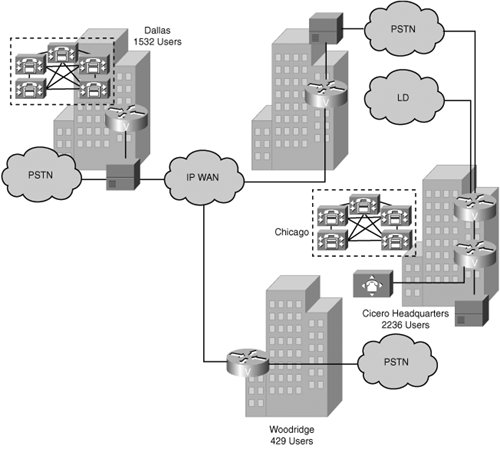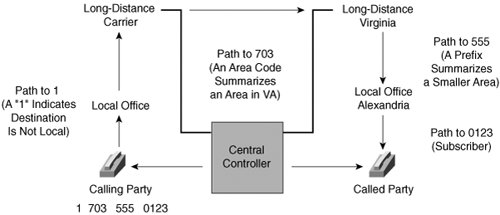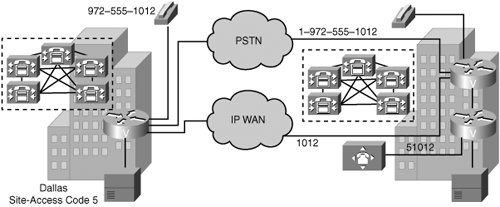| To integrate VoIP networks into existing voice networks, network administrators must have the skills and knowledge to implement a scalable numbering plan and a comprehensive, scalable, and logical dial plan. This section describes the attributes of numbering plans and scalable dial plans for voice networks, addresses the challenges of designing these plans, and identifies the methods of implementing dial plans. Numbering Plans and Dial Plans Implementing a VoIP network involves designing a numbering plan for all endpoints or reviewing an existing numbering plan for scalability and completeness. A dial plan can be designed only after the numbering plan has been completed and call patterns and connectivity to the PSTN are understood. All implementations of VoIP require both a numbering plan and a dial plan: Numbering plan A numbering plan identifies each VoIP endpoint and application in the network with a unique telephone number. Numbering plan design should evaluate both current requirements and potential growth requirements to avoid the need to renumber as more users connect to the voice network. Types of numbering plans include the following: - - The Public International Telecommunications Numbering Plan (E.164) The E.164 standard defines the use of a one-, two-, or three-digit country code, followed by the national destination code, followed by the subscriber number.
- - National numbering plans A national numbering plan defines the numbering structure for a specific country or group of countries. An example is the North American Numbering Plan (NANP). It defines a ten-digit numbering plan. First is a three-digit Numbering Plan Area (NPA) commonly referred to as the area code. Next is a three-digit central office code. Finally, there is a four-digit subscriber line number. The United States, Canada, and parts of the Caribbean all use the NANP for number assignment. Other countries have differing national numbering plans. Familiarity with these plans is required when planning an international voice network.
- - Private numbering plans Private numbering plans are used to address endpoints and applications within private networks. Private numbering plans are not required to adhere to any specific format and can be created to accommodate the needs of the network. Because most private telephone networks connect to the PSTN at some point in the design, it is good practice to plan the private numbering plan to coincide with publicly assigned number ranges. Number translation might be required when connecting private voice networks to the PSTN.
Dial plan The dial plan is a key element of an IP telephony system and an integral part of all call-processing agents. Generally, the dial plan is responsible for instructing the call-processing agent on how to route calls. Primary functions of a dial plan include: - - Endpoint addressing Reachability of internal destinations is provided by assigning directory numbers (DNs) to all endpoints (such as IP phones, fax machines, and analog phones) and applications (such as voice mail systems, auto attendants, and conferencing systems). DN assignment is based on the implemented numbering plan.
- - Path selection Depending on the calling device, different paths can be selected to reach the same destination. Moreover, a secondary path can be used when the primary path is not available. For example, a call can be transparently rerouted over the PSTN during an IP WAN outage.
- - Calling privileges Different groups of devices can be assigned to different classes of service by granting or denying access to certain destinations. For example, lobby phones might be allowed to reach only internal and local PSTN destinations, while executive phones could have unrestricted PSTN access.
- - Digit manipulation In some cases, it is necessary to manipulate the dialed string before routing the call. One example would be when rerouting a call over the PSTN that was originally dialed using the on-net access code. Another would be expanding an abbreviated code, such as expanding a 0 for the operator, to an extension.
- - Call coverage Special groups of devices can be created to handle incoming calls for a certain service according to different algorithms. These call coverage algorithms might include top-down, circular hunt, longest idle, or broadcast.
- - Overlapping number processing In some cases, administrators are tasked with connecting two or more voice networks with overlapping number ranges. For example, when two companies merge, company X might have a user number range of 1xxx, and company Y might also use the number range of 1xxx. When dealing with overlapping number ranges, one solution is to assign a unique site-access code to each individual location. Users would then dial the access code, followed by the extension number. The number of digits used for the access code would depend on the total number of locations affected.
Figure 5-9 shows the topology for Span Engineering LLC, the previously introduced fictitious company being used for illustrative purposes. Span Engineering's numbering plan is presented in Table 5-4. Figure 5-9. Span Engineering's Numbering Plan 
Table 5-4. Span Engineering Numbering Plan ExampleLocation | Numbering Plan |
|---|
Cicero | 708-555-1xxx 708-555-2xxx 708-555-3xxx | Woodridge | 331-555-4xxx | ORD | 630-555-5xxx | Dallas | 972-555-1xxx 972-555-2xxx |
Span Engineering has multiple locations and is currently evaluating the numbering plan associated with its Chicago campuses and the Dallas location. The numbering plan design process includes enumerating the number of current users at each location and evaluating future growth requirements. The internal numbering plan will use the PSTN-assigned direct inward dial (DID) numbers that have been allocated at each site. Figure 5-10 depicts Span Engineering's dial plan requirements. Figure 5-10. Span Engineering's Dial Plan Requirements 
Span Engineering's dial plan requirements include the following: Single-digit [18] access code identifying each campus Single-digit [9] access code that directs calls to the local PSTN Intrasite dialing that is based on the four-digit extension Intersite dialing that is based on the access code plus the four-digit extension Local PSTN access that requires the access code 9 followed by the ten-digit number and also requires that the 9 be stripped and the ten digits passed to the PSTN switch Long-distance PSTN access that requires the access code 9 followed by the digit 1, followed by the ten-digit number and also requires the 9 be stripped and the 11 digits passed to the PSTN switch
With this basic understanding of numbering plans and dial plans, the following sections discuss design considerations surrounding hierarchical numbering plans, internal numbering, and public numbering plan integration. Hierarchical Numbering Plans The previous section discussed the Public International Telecommunications Numbering Plan (E.164), national numbering plans, and private numbering plans. Each of the numbering plans can benefit, in terms of scalability, from a hierarchical design. A hierarchical design has the following advantages: Simplified provisioning Refers to the ability to easily add new groups and modify existing groups Simplified routing Keeps local calls local and uses a specialized number, such as an area code, for long-distance calls Summarization Establishes groups of numbers in a specific geographical area or functional group Scalability Provides additional high-level number groups Management Controls number groups from a single point in the overall network
The North American Numbering Plan (NANP) serves as a good role model for a scalable numbering plan. Consider how the NANP might be adapted to your environment. To illustrate the operation of the NANP, examine Figure 5-11. Figure 5-11. Hierarchical Numbering Plan 
In Figure 5-11, the calling party dials 1-703-555-0123. The calling party's local central office (CO) forwards the call to a long-distance carrier because the first digit (that is, the 1) indicated the call was a long-distance call. The long-distance carrier then forwards the call, based on the dialed area code, to a Virginia long-distance office. The Virginia long-distance office forwards the call, based on the CO code (that is, the NXX code), to an Alexandria CO. Finally, the Alexandria CO, based on the last four digits, forwards the call out to the called party. While the NANP acts as a good starting point in designing a numbering plan, it is not always easy to design a hierarchical numbering plan. Existing numbering plans in the network might include proprietary PBXs, key systems, and telephony services such as a Centrex service. The necessity to conform to the PSTN at the gateways also contributes to the complexity of the design. Translation between these systems is a difficult task. If possible, avoid retraining system users. The goal is to design a numbering plan that has the following attributes: Minimal impact on existing systems Minimal impact on users of the system Minimal translation configuration Consideration of anticipated growth
Span Engineering LLC will use the full ten-digit DID numbers that are assigned by the PSTN for the company's internal numbering plan. Using the ten-digit numbers provides Span Engineering with the following benefits: Allows easy integration to the PSTN at each local campus with minimal digit manipulation Allows dial plans to summarize call routing for sites that use multiple number ranges Provides flexibility for the dial plan to use shorter dialing patterns as extensions within the voice network
Internal Numbering and Public Numbering Plan Integration Numbering plans vary greatly throughout the world. Different countries use different number lengths and hierarchical plans within their borders. Telephony equipment manufacturers and service providers use nonstandard numbering. In an attempt to standardize numbering plans, the ITU developed the E.164 worldwide prefix scheme. Numbering plan integration from an internal system such as a VoIP and PBX system to the PSTN requires careful planning. The hierarchical structure of the numbering plan and the problems associated with varying number lengths in different systems make numbering plan integration complex. The challenges faced with numbering plan integration include the following: Varying number lengths Within the IP network, consideration is given to varying number lengths that exist outside the IP network. Local, long-distance, key-system, and Centrex dialing from within the IP network might require digit manipulation. Specialized services Services such as Centrex and their equivalents typically have four- or five-digit numbers. Dialing from the PSTN into a private VoIP network and then out to a Centrex extension can also require extensive digit manipulation. Voice mail When a called party cannot be reached, the network might have to redirect the call to voice mail. Since the voice mail system can require a completely different numbering plan than the endpoint telephones, translation is necessary. Necessity of prefixes or area codes It can be necessary to strip or add area codes, or prepend or replace prefixes. Rerouting calls from the IP network to the PSTN for failure recovery can require extra digits. International dialing consideration Country codes and numbering plans vary in length within countries. Dialing through an IP network to another country requires careful consideration.
In Figure 5-12, Span Engineering LLC uses the PSTN as a backup route for calls between Cicero and Dallas. Figure 5-12. Span Engineering Integration of Internal and Public Numbering Plans 
The following list enumerates the call setup steps shown in Figure 5-12: The Cicero caller dials the site-access code for Dallas (5) followed by the four-digit extension number of the destination phone (1012). The voice gateway determines whether the call can be completed using the IP WAN or whether it must be routed via the PSTN. Digit manipulation occurs based on the path chosen. The gateway strips the site-access code and sends four digits if completing the call across the IP WAN. The gateway strips the site-access code and prepends 1-972-555 if completing the call across the PSTN.
|



